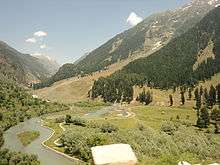Betaab Valley
| Betaab Valley | |
| Valley | |
 Betaab Valley | |
| Country | |
|---|---|
| State | Jammu and Kashmir |
| Region | Kashmir Valley |
| District | Anantnag |
| Municipality | Pahalgam |
| Borders on | Sind Valley (North) Lidder Valley (West) |
| Parts | Lidder Valley |
| River | Lidder River |
| Elevation | 7,851 ft (2,393 m) |
| Coordinates | 34°3′1.476″N 75°21′49.716″E / 34.05041000°N 75.36381000°ECoordinates: 34°3′1.476″N 75°21′49.716″E / 34.05041000°N 75.36381000°E |
| Length | 7 mi (11 km) |
| Width | 2 mi (3 km) |
| Easiest access | NH 1A |
Betaab valley is situated at a distance of 15 kilometers from Pahalgam in Anantnag district in India's northernmost state of Jammu and Kashmir. The valley got its name from the Sunny Deol-Amrita Singh hit debut film Betaab.[1] The Valley is towards northeast of Pahalgam and falls between Pahalgam and Chandanwadi and is en route Amarnath Temple Yatra. The valley surrounded by lush green meadows, snow clad mountains and covered with dense vegetation.
History

Betaab Valley, which is a part of Pahalgam area – one of the several Sub-valleys of Kashmir Valley came into existence during the post geosynclinal stage of the development of the Himalayas. Betaab Valley lies between the two Himalayan Ranges – Pir Panjal and Zanskar. Archaeological evidence proves the human existence in this region from the Neolithic Age, especially at Burzahom, Bomai and Pahalgam. Betaab Valley – a part of the Kashmir region, was ruled by the Mughals since the 15th Century. In latter part of the 15th century the Turko-Mughal Military General Mirza Muhammad Haidar Dughlat ruled over Kashmir first on behalf of Sultan Said Khan of Kashgar and then on behalf of the Mughal Emperor Humayun. A polyglot and a historical writer, General Haider wrote the ‘Tarik-i-Rashidi’ – a personal memoir of the Central Asian History.
Sultan Ghiyas-ud-Din Zain-ul-Abidin known by all his courtiers and Nobles as the greatest local King ruled the entire Kashmir region for about 40 years during which he was famous for promoting peace and harmony in Kashmir’s pluralistic society. He even gave a directive to restore and restructure Kashmir during his reign – quite contrary to conventional foreign invading rulers. It was under him that ‘Kashmiriyat’ – a ‘social and cultural consciousness’ of Kashmiri people was developed.[2]

Tourism

Betab Valley is a very popular touristic destination. Betaab Valley is also a favorite campsite of travelers as it also serves as a base camp for trekking and further exploration of the mountains.[3] The valley is a walk-able distance from Pahalgam. The crystal clear & chilly water of the stream bubbling down from the snowy hills is a delight; locals here drink this water too. Baisaran and Tulian Lake are few nearby attractions that can be visited.[4]
In popular culture
Kashmir was home to the Indian film industry from the sixties to the eighties. Scores of films were shot in the Valley like Aarzoo, Kashmir Ki Kali, Jab Jab Phool Khile, Kabhie Kabhie, Silsila, Satte Pe Satta and Roti (1974 film), the list is endless. Film shooting almost came to a halt after militancy erupted in the Valley but with things improving now, one can hope that Bollywood would soon return to what many believe is its original home. The threat of militancy was a deterrent for over 30 years but with director Imtiaz Ali shooting for his film Rockstar (2011 film) in the beautiful valley with actors Ranbir Kapoor and Nargis Fakhri, the violence seems to be a thing of the past.[5] The hut where Bobby was shot continues to be famous as the 'Bobby Hut'.[6] Many films like Jab Tak Hai Jaan,Yeh Jawani Hai deewani, Haider have been shot in the Jammu and Kashmir state.[7][8]
References
| Wikimedia Commons has media related to Betaab Valley. |
- ↑ "Betaab Valley". NDTV. Retrieved 29 August 2012.
- ↑ "Hop around India". Retrieved 29 August 2012.
- ↑ "Trekking in Jammu and Kashmir". Retrieved 29 August 2012.
- ↑ "Must see India".
- ↑ "Bollywood returns to Kashmir, its original home". Retrieved 29 August 2012.
- ↑ "My father's unfulfilled wish was to bring me to Kashmir, SRK gets nostalgic on first visit to Kashmir".
- ↑ Share on Twitter (2014-02-07). "Bollywood returns to their favourite destination Kashmir - Times of India". Timesofindia.indiatimes.com. Retrieved 2016-01-01.
- ↑ Mankermi, Shivani (2014-01-24). "WEEKEND ENTERTAINMENT: Why Bollywood is once again scouting for fresh locales in Kashmir | Daily Mail Online". Dailymail.co.uk. Retrieved 2016-01-01.